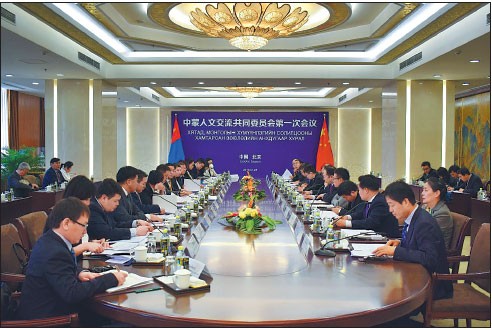Mongolian foreign minister envisages flourishing time of growth, bilateral trade
With a high-powered Mongolian delegation headed by Prime Minister Khurelsukh Ukhnaa visiting China from Monday to Thursday, the move is set to "expand the comprehensive strategic partnership" between the two nations, a senior minister said.
Mongolian Foreign Minister Tsogtbaatar Damdin, also a member of the delegation, made his remarks in an exclusive interview with China Daily prior to the state visit.
During the visit, the two countries are expected to sign a package of bilateral projects worth over $1 billion, the minister said.
China has remained Mongolia's largest trading partner for more than 10 consecutive years. The latest data from the Chinese Ministry of Commerce showed bilateral trade volume surged 46.3 percent year-on-year to $3.62 billion in the first seven months of last year.
The driving force is understandably the economic growth of both countries, as expanding economies interact more intensively and more actively, the foreign minister said.
"The exemplary strategic partnership between our countries is also a crucial solid base for the growth of trade and commerce between our countries," he said.
The foreign minister cited various joint projects, including the Zamiin-Uud-Erlian cross-border economic zone, as examples to illustrate the governments' contribution to that growth.
Mongolia's trading volume with China reached $6.7 billion last year, accounting for 63 percent of its total foreign trade, with mineral product exports to China serving as a main driver of the growth, according to Mongolian government statistics.
Mongolia's exports to China reached $5.2 billion last year, and China was the only trading partner with which Mongolia enjoyed a favorable balance of trade, the statistics showed.
The goal is for the bilateral trading volume to hit the $10 billion level in 2020.
Trade in non-mining sectors, including agricultural products, light industry, tourism, renewable energy, and services, needs to be expanded over the next decade, the Mongolian foreign minister said.
He added that if the countries could reach that level of bilateral trade through growth in these sectors, it would be a watershed achievement that would define the future of their cooperation.
A key part of efforts to further spur trade growth was the signing by Mongolia and China in May last year of a memorandum of understanding, pledging to launch a joint feasibility study into establishing a Sino-Mongolia free trade zone.
As Mongolia's second-biggest source of foreign investment, China ranks No 1 in terms of the number of foreign-funded enterprises established in the neighboring country, according to data from the Mongolian government.
"One of the areas we also want to progress during the visit is increased cooperation in the field of small and medium-sized enterprises, and in the field of facilitating and supporting SMEs in both countries," the minister said.
In addition to the mining industry, the Mongolian foreign minister said he expected the manufacturing, processing, technological exchanges and environmental protection sectors to be key investment hot spots.
"Investment in infrastructure construction is laying an important foundation to further facilitate trade across all the sectors, be it mining, manufacturing or services," he said.
"We highly value the role played by Chinese government assistance and loans in Mongolia's economic development," the minister said, adding that there were many public infrastructure facilities around his country funded by Chinese grants and loans.
In the coming years, Chinese grants and loans will continue to be used to advance infrastructure projects, such as wastewater treatment, as well as public facilities including schools and kindergartens, the minister added.
The cooperation under the framework of the Belt and Road Initiative would be also on the agenda during the state visit, he noted.
The initiative proposed by China in 2013 covers the Silk Road Economic Belt and the 21st Century Maritime Silk Road, aimed at increasing international cooperation.
"Mongolia has been supportive of the initiative from the very beginning," he said.
"We welcomed the initiative because we see it as a new push to spread the benefits of openness and regional integration.
"This initiative in the current context is a positive example in the light of protectionist trends in global trade."
Facing the economic difficulties in the modern intertwined and interrelated world, countries could not handle them one-by-one on their own, he said.
"The initiative can be a very effective instrument that contributes to creating a shared future for the world and shared growth for its economies," the minister said.
"It is not only a contributing factor, but also a necessary ingredient in maintaining peace and prosperity."
Mongolia and China signed a bilateral MOU, for aligning Mongolia's own Development Road program with the Belt and Road Initiative last year.
Another move Mongolia is making in response to the initiative is to create a Peace, Progress, Prosperity and Promise award under the aegis of a Silk Road-related institutional framework and what its government has called a "Belt and Road Travel Facilitation Initiative."
The PPPP award could be used to encourage junior diplomats and scholars who come up with innovative ideas and research in the field of promoting peace, the foreign minister said. The travel facilitation initiative is designed to create green channels for Belt and Road officials and investors, Damdin said.
"We have already created a special lane at our border points for diplomats and investors on Belt and Road-related missions."
wangxin@chinadaily.com.cn

The Mongolia-China Joint Committee on Humanitarian Exchanges holds its first meeting in Beijing in January.Provided To China Daily



 Print
Print Mail
Mail


